 Welcome back to another great Science Friday! This week: how different is sci-fi from real science? What do pieces of an actual asteroid look like? How do enigmatic Martian spirals form? And how do humans perceive themselves? Answers to these questions and more, plus our gadget of the week: the creepy, gel-filled refrigerator of the future!
Welcome back to another great Science Friday! This week: how different is sci-fi from real science? What do pieces of an actual asteroid look like? How do enigmatic Martian spirals form? And how do humans perceive themselves? Answers to these questions and more, plus our gadget of the week: the creepy, gel-filled refrigerator of the future!
“Physics of Star Trek” Author’s on Sci-Fi’s view of Science
Lawrence Krauss, physicist at Arizona State University and author of “The Physics of Star Trek,” wrote last week in a piece for The Wall Street Journal about science fiction versus science fact and the dangers of confusing the two. Case in point? The reaction to the recent gulf oil spill.
“As the world watches the crude gushing relentlessly, everyone seems to be asking: Where are the scientists? And why can’t they fix this? Perhaps we have become victims of our own fascination with the quick fixes that television science has offered. Since the days of Scottie on through Data and Geordi and the holographic doctor in the various Star Trek incarnations, pop culture has convinced us that engineers can save the day at the last minute—and literally in minutes—when presented with the challenge of staving off a warp core breach or curing a disease.”
Krauss makes the point that in science, breakthroughs more commonly occur through baby steps rather than giant leaps like we see happen so often on science fiction shows like Star Trek.
“As I often tell people when I speak to a room with more Klingons than [humans]: Star Trek is science fiction. The operative word here is fiction. The real world is far more complicated and far less well understood. That’s why we need good science now more than ever.”
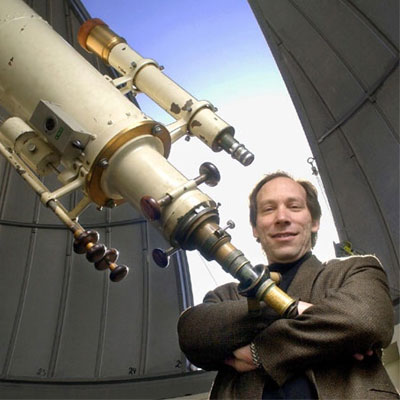
Dr. Krauss offers up advice for sci-fi fans’ view of science
JAXA Hayabusa Spacecraft Returns to Earth
This week, the Japanese Hayabusa Spacecraft made a fiery re-entry into the Earth’s atmosphere after spending seven years in space during which it collected samples from the surface of an asteroid. Bringing samples back to Earth from an asteroid is a world first. The capsule entered the atmosphere at 7 1/2 miles per second. The sample capsule touched down in tact in an unpopulated region of southern Australia. Scientists have recovered the samples and will soon begin work on their analysis. The video below was captured by American and Japanese scientists aboard NASA’s DC-8 laboratory.
Strange Martian Spirals Explained
Almost 40 years ago, NASA’s Mariner 9 spacecraft relayed to Earth the first video images of Mars’ northern polar ice cap, revealing a strange pattern of spiral swirls that has puzzled scientists ever since. Using new data from the Mars Reconnaissance Orbiter (MRO), Jack Holt of the University of Texas and his graduate student Isaac Smith have discovered that the shapes are carved by wind. Not only does wind shape the spirals, but also it causes them to move. They rotate around the north pole, turning like an excruciatingly slow pinwheel, curiously enough, against the wind. Smith explains the process: “Cold air from the top of the ice cap sweeps down the slope, gaining speed and picking up water vapor and ice particles along the way. As this wind blows across the trough and starts up the other slope (the cooler side, facing away from the sun), it slows and precipitates the ice it holds. All of this ice is deposited on this cool slope, building it up, so the trough actually grows and migrates, over time, against the wind.” (via NASA Science)
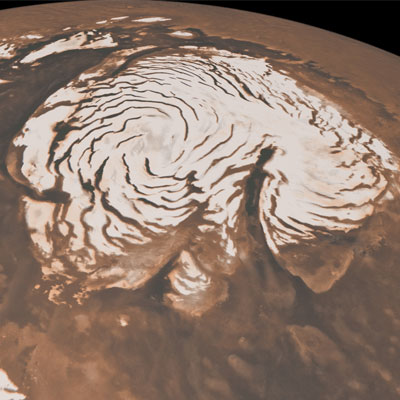
Image of Mars’s crazy north polar spirals
Hand Study Reveals Brain’s Distorted Body Image
According to a new study on how humans perceive their own hands, our brains contain a very distorted image of our own bodies. The study at University College London (UCL) has shown that people tend to visualize their own hands as being shorter and fatter than they actually are. It is this model of our body’s size and shape that is investigated in the study. “Of course, we know what our hand really looks like” said Dr Longo, “and our participants were very accurate in picking out a photo of their own hand from a set of photos with various distortions of hand shape. So there is clearly a conscious visual image of the body as well. But that visual image seems not to be used for position sense.” Scientists say that this body image distortion probably applies to other body parts as well and may be a factor in contributing to psychiatric disorders such as anorexia.
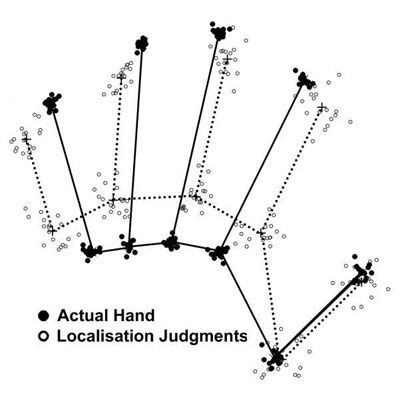
Diagram of actual versus perceived hand size
Picture of the Week: Lava dome in Kelud volcano, Java, Indonesia
This incredible image from Tom Pfeiffer of volcanodiscovery.com is of a growing lava dome inside the caldera of Kelud volcano in Java, Indonesia. The growth of the lava dome gradually displaced the crater lake.
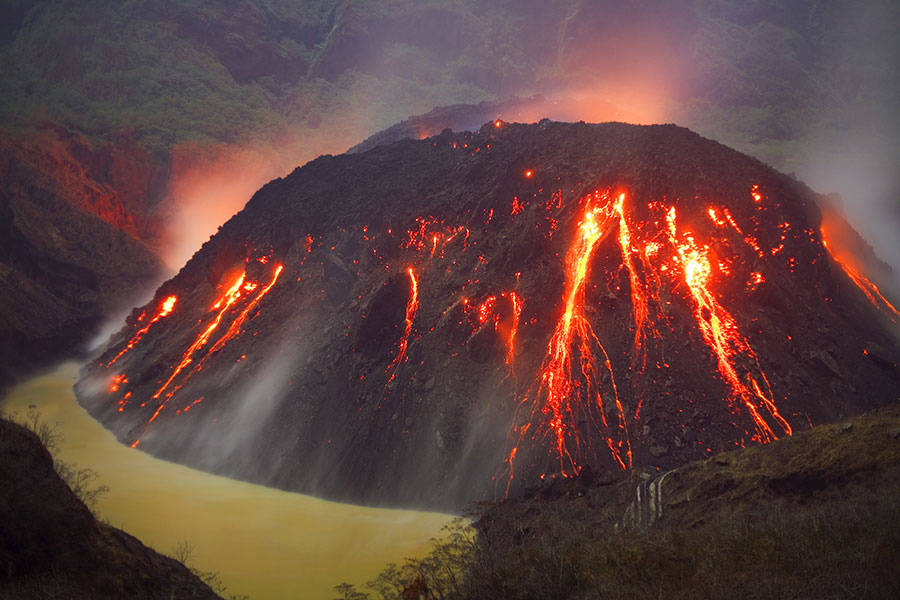
Check out more amazing volcano pictures on Volcano Picture of the Week!
Gadget of the Week: Creepy, Gel-filled Refrigerator of the Future
In the future, refrigerators won’t be like they are today. They will be slimmer and without any doors, shelving, or …cooling? That’s the plan according to Russian designer Yuriy Dmitriev, whose fridge design is one of the 25 finalists for the Electrolux Design Lab contest. Instead of a refrigerated box, all you need is apparently a cupboard full of creepy green “biopolymer gel” to stick your food into.

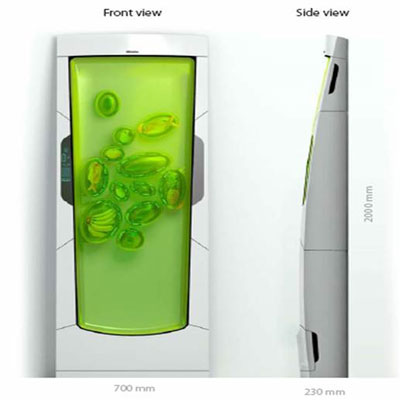
Creepy goo-filled fridge of the future
#FollowFriday
If you are on Twitter, you know there are plenty of amazing people out there tweeting away. And, many of them are scientists! Every Friday I’ll be bringing you a new list of great scientists, techies, and trekkies to follow on Twitter. This week…
- @Exoplanetology: The Art and Science of New Worlds. Explores Astronomy, Astrophysics and Astrobiology in relation to Humanity’s Culture and Future.
- @glennztees: A tee shirt design company based in Austin, TX with tons of great Trek (and other) designs.
- @thevolcanolady: Volcano Hunter,National Geographic Photographer/Explorer, Devoted Wife, If I was a drink I’d be a peppermint hot chocolate.
Science Quickies
Not enough science for you? Here’s a warp-speed look at some more science tid-bits that are worth a look.
- Six new planets discovered
- Rosetta Spacecraft’s blind date with asteroid Lutetia
- Study finds that moon has more water than thought before
TrekMovie’s Science Friday is an homage the the great NPR radio show Science Friday. Science Friday® is a registered service mark of ScienceFriday Inc.

The refrigerator is giving me the willies. first?
The Creepy Slimmer Fridge will be the Art Deco of the future but does look cool to look at.
Would not want to wipe away the green slim from my food each and every time though.
First?!?!?
that fridge is nothing new. back in my dorm days, you could find ones like that in many rooms…
oh great so we go from refrigerators to gooey biostasis chambers… problem is with that model anything thick as a container of ice cream or a bottle of soda wouldnt fit… therefore I submit that this goofridge is highly illogical and creeps the almighty shat outta me…
The gel-refrigerator is totally cool.
Fith?! FITH?! Yeah! :-)
“As I often tell people when I speak to a room with more Klingons than [humans]: Star Trek is science fiction”
Dr. Krauss, you have dashed my hopes and dreams to pieces. Life is not worth living anymore. Darn, I was all prepared for the Enterprise to land in my backyard! What are you saying?! Whaddaya mean Star Trek isn’t non-fiction?!?! Oh, the shock is overwhelming…..
Science fiction…FICTION!!! You mean all those pointless debates on the design of the Enterprise in the last movie were a waste??!! People spoke with such passion, it had to be real, right? I’m crushed….
Oh, and I’m all for plugging the leaking oil well in the gulf the James Cameron. At last, a Hollywood type would finally be able to reduce a bit of pollution in the would, as opposed to contributing to it….
@Polly True, true. But, I don’t think Krauss means to downplay the intelligence of Trekkies. I believe they are amongst the most scientifically literate of sci-fi fans. But, it is true that many people don’t realize how different actual science is. It takes decades to take big steps forward in science. Decades of research and analysis. Certainly not plug-and-play as in the movies. I think Krauss just wants to remind people of that, as it is easy to forget and to hold science on such a high pedestal.
What he speaks of is today’s science. Trek science is science of the future. The baby steps as he put it have been taken. New established is in place for geordi and Data to draw upon. His view is like oh there is no ure for cancer today therefore no cure will be here 300 years from now oh how optimistic! Reality is built starting fro dreams and visions. Then hard work and research and persavearence.
Can the fridge “slime” you?
RE Science vs.Sci-Fi:
All that Americuh “knows” is what they consume on TV, so… d’uh…
RE the obscene insane unstoppable fountain of filth and death in the gulf:
this is a problem that will (HOPEFULLY) be solved using engineering, not science.
BTW Kayla, EXCELLENT job as always.
I like that fridge!
At long last … a fridge you can put bananas in (those ARE bananas in there, lower left, yes?). How does goofridge work, anyway?
Scott B. out.
Maybe it is only on this web site, but why does the volcano look like a giant Horta?
My fridge is already filled with creepy, green “biopolymer” goo.
Next.
Don’t ever ever put bananas in the refrigerator, oh no no no. – Chiquita
You know, while I agree with Dr. Krauss assertations that science breakthroughs are made in baby steps…science is also advanced in leaps by folks who think “outside of the box” and take chances, which, to paraphrase a movie, “Is something I think we’ve lost.”
I watched a show where there were several people who proposed reasonable ideas to assist with helping either clean up or stop the spill. They had even called BP with their ideas and never received any recognition that their idea had been received. One was a PhD from Harvard, but she has the unfortunate problem that she still sounds like a “Valley Girl”. Another group showed that plain ordinary hay…the type of which as I drove around my old farming hometown there were piles of it just slowly rotting away because it had gotten too wet to be used for feed, and then drys out and becomes a fire hazard, still soaks up sizeable amounts of oil. Those folks have been ignored too…because they sound like Hillbillies from the deepest Arkansas hills.
I agree that some ideas are definately far out there. But I think we have a tendancy to also ignore good ideas, just because the person presenting them doesn’t match our “vision” of a visionary.